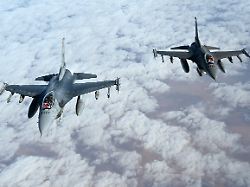Kiev gets the long-awaited F-16s from Europe. But before the Ukrainians can deploy the fighter jets, they face a number of problems. Despite this, the Ukrainian Air Force needs the jets more than ever.
For the Ukrainian President Volodymyr Zelenskyj, the long journey to Japan for the G7 summit was worth it. After a weekend of talks, he returned to Ukraine with the prospect of fulfilling a long-awaited promise: after months of pleading, the US and Europe want to grant F-16 fighter jets. When the planes will be delivered is still open – but they should come.
For the Ukrainian army, the F-16 jets will be a turning point in air defense. The fighter planes are considered to be extremely powerful. More than 2800 copies were recently in use worldwide. This makes the F-16 jet 15 percent of the global fleet, making it the most popular fighter jet in the world. Kiev is therefore hoping to get larger quantities and no major problems in procuring spare parts.
In addition to many advantages, the fighter jets also bring a number of challenges. Despite the uncomplicated procurement of spare parts, the maintenance of the fighter planes could be difficult, according to a report by the US broadcaster CNN. According to military experts, 16 hours of maintenance can be expected per hour of flight time.
According to a report by the Congressional Research Service (CRS), the scientific service of the parliament in Washington, the training of the maintenance staff even exceeds that of the pilots. A Ukrainian pilot could learn to fly an F-16 in three months. But training maintenance staff can take months or even years, depending on the skill level desired. Even after 133 days of training, a U.S. Air Force maintenance technician gains a year of work experience to fully qualify, writes the CRS.
Training could take years
As far as pilot training goes, three months of training is just enough for the basics: get the plane airborne, hold it there, and land safely again. Combat operations or night ground attacks could not be carried out yet. “Learning to fly an F-16 is only part of the battle,” a US pilot trained on the F-16 jet told CNN. F-16s are easy to learn, but using them effectively in a “dynamic threat environment” could take years, the pilot said.
This is exactly why the F-16s are so important to Ukraine. “This would put the Ukraine in a position to establish the appropriate air sovereignty over the area to be taken over in the event of an attack by the Ukrainian ground forces,” says Colonel Markus Reisner of the Austrian Armed Forces ntv.de. However, the time to support the expected ground offensive with F-16 is likely to be short.
On the other hand, Ukrainian pilots have a history of proving themselves to be very adept, learning how to handle new aircraft faster than Western experts predicted. Poland is said to have already started training pilots. According to former Royal Australian Air Force officer at the Griffith Asia Institute Peter Layton, pilots could learn the F-16s “on the job” by limiting themselves to short-term air defense and firing at intruding Russian planes or missiles.
However, the expert lacks the imagination for all further combat operations: “I can’t imagine that you can teach them low-altitude ground attacks at night and in any weather using infrared systems and laser-guided bombs. That would take longer,” Layton told CNN.
How to hide the F-16 from the Russians?
Then the question arises of where to base the F-16s. According to experts, machines of this type can operate best on long and naturally intact runways. However, Ukrainian airfields mainly have outdated and uneven runways that date back to Soviet times. These may need to be repaired or even extended before the F-16 jets can be stationed – a process that the Russians would likely notice. However, if only a few airfields are suitable and are in known locations, targeted Russian attacks could prevent the F-16 jets from flying.
Even if Ukraine finds a solution for safe runways, the ammunition problem remains. According to the CRS report, Ukraine would need large quantities of western ammunition to be prepared against Russia’s most important fighter jets such as the Su-25 and MiG-31 – and arming the F-16 would be expensive.
“It’s not just about the aircraft alone, but also about the corresponding weapon systems that this aircraft can shoot down,” says military expert Reisner. This would include, for example, missiles to hit enemy aircraft or airborne weapons, “i.e. bombs that have a targeted and precise effect”. The burden of supplying ammunition could be spread across several shoulders. Other nations that don’t have F-16s, like Germany or Great Britain, could contribute in this way. “The big challenge in using this program is not the availability of the missiles themselves, but the availability of the weapon carriers. So how many fighter planes do I have to deploy this at the same time?” said Reisner.
Despite all the difficulties, the delivery of F-16s to Ukraine is essential. Russia is constantly using new weapons such as glide bombs or kamikaze drones, against which Ukraine can do little without fighter jets. According to Reisner, the Russian air force also has the ability to work deep in the country. “All of this shows that Ukraine needs massive support if it wants to keep defending – and winning – its country.”
